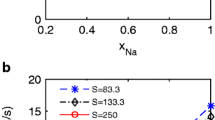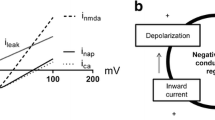Summary
The change in membrane capacitance and conductance of squid giant axons during hyper- and depolarizations was investigated. The measurements of capacitance and conductance were performed using an admittance bridge with resting, hyperpolarized and depolarized membranes. The duration of DC pulses is 20–40 msec and is long enough to permit the admittance measurements between 1 and 50 kHz. The amplitudes of DC pulses were varied between 0 and 40mV for both depolarization and hyperpolarization. Within these limited experimental conditions, we found a substantial increase in membrane capacitance with depolarization and a decrease with hyperpolarization. Our results indicate that the change in membrane capacitance will increase further if low frequencies are used with larger depolarizing pulses. The change in membrane capacitance is frequency dependent and it increases with decreasing frequencies. The analyses based on an equivalent circuit (vide infra) gives rise to a time constant of active membrane capacitance close to that of sodium currents. This result indicates that the observed capacitance changes may arise from sodium channels. A brief discussion is given on the nature of frequency-dependent membrane capacitance of nerve axons.
Similar content being viewed by others
References
Armstrong, C.M., Bezanilla, F. 1973. Currents related to movement of the gating particles of the sodium channels.Nature 242:459
Bergman, K., Eigen, M., De Mayer, L. 1963. Dielektrische Absorption als Folge Chemischer Relaxation.Ber. Bunsenges. Phys. Chem. 67:819
Bezanilla, F., Armstrong, C.M. 1974. Gating currents of the sodium channel: Three ways to block them.Science 183:753
Chandler, W.K., Fitzhugh, R., Cole, K.S. 1962. Theoretical stability properties of a spaceclamped axon.Biophys. J. 2:105
Cole, K.S. 1932. Electric phase angle of cell membranes.J. Gen. Physiol. 15:641
Cole, K.S. 1968. Membranes, Ions and Impulses. University of California Press, Berkeley, California
Cole, K.S., Baker, R.F. 1941. Transverse impedance of the squid axon during current flow.J. Gen. Physiol. 24:535
Cole, K.S., Curtis, H.J. 1938. Electrical impedance of nerve during activity.Nature 142:209
Cole, K.S., Curtis, H.J. 1939. Electrical impedance of the squid giant axon during activity.J. Gen. Physiol. 22:649
Feldman, L., Guttman, R. 1975. Effect of low Ca and polarization upon impedance of space clamped squid axons stimulated by white noise as derived from input-out cross correlations. Annual Meeting of Biophysical Society, Philadelphia, Pa. (Abstract F-AM-b2)
Hodgkin, A.L., Huxley, A.F. 1952. A quantitative description of membrane current and its application to conduction and excitation in nerve.J. Physiol. 117:500
Keynes, R.D., Rojas, E. 1974. Kinetics and steady-state properties of the charged system controlling sodium conductance in the squid giant axons.J. Physiol. 239:393
Majer, B.A. 1973. Analysis of the linearized ionic current contribution to the membrane properties in the Hodgkin-Huxley membrane. Master's Thesis, University of Pennsylvania, Philadelphia, Pa.
Meves, H. 1974. The effect of holding potential on the asymmetry currents in squid giant axons.J. Physiol. 243:847
Moore, J.W., Cole, K.S. 1963. Voltage clamp techniques.In: Physical Techniques in Biological Research. W.L. Nastuk, Editor. Vol. VI, chapter 5. Academic Press Inc., New York
Schwan, H.P. 1957. Electrical properties of tissue and cell suspension.In: Advances in Biological and Medical Physics. J.H. Lawrence and C.A. Tobias, Editors. Vol. V, p. 147. Academic Press Inc., New York
Schwan, H.P. 1963. Determination of biological impedance.In: Physical Techniques in Biological Research. W.L. Nastuk, Editor Vol. VI, chapter 6. Academic Press Inc., New York
Schwan, H.P. 1965. Biological impedance determinations.J. Cell. Comp. Physiol. 66:5
Schwan, H.P. 1966. Membrane properties-AC state studies.Second International Biophysics Congress, Vienna (Paper Sy-IA)
Schwan, H.P., Schwarz, G., Maczuk, J., Pauly, H. 1962. On the low frequency dielectric dispersion of colloidal particles in electrolyte solution.J. Phys. Chem. 66:2626
Schwarz, G. 1962. A theory of the low frequency dielectric dispersion of colloidal particles in electrolyte solution.J. Physic. Chem. 66:2636
Schwarz, G. 1967. On dielectric relaxation due to chemical rate processes.J. Phys. Chem. 71:4021
Takashima, S. 1969. Dielectric properties of proteins. I. Dielectric relaxation.In: Physical Principles and Techniques of Protein Chemistry. S.J. Leach, Editor. p. 291. Academic Press, Inc., New York
Takashima, S. Minakata, A. 1975. Dielectric behavior of biological macromolecules.In: Digest of Dielectric Literature. W. Vaughn, Editor. National Research Council, National Academy of Sciences (In press)
Takashima, S., Schwan, H.P. 1974. Passive electrical properties of squid axon membrane.J. Membrane Biol. 17:51
Author information
Authors and Affiliations
Rights and permissions
About this article
Cite this article
Takashima, S. Membrane capacity of squid giant axon during hyper- and depolarizations. J. Membrain Biol. 27, 21–39 (1976). https://doi.org/10.1007/BF01869127
Received:
Revised:
Issue Date:
DOI: https://doi.org/10.1007/BF01869127




